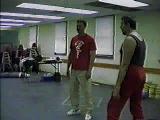
(QuickTime, ~244k) |
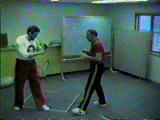
(QuickTime, ~171k) |
|
Windows Users: download Quicktime for Windows if you do not already have it. | |


(QuickTime, ~244k) |

(QuickTime, ~171k) |
|
Windows Users: download Quicktime for Windows if you do not already have it. | |
You can imagine a buggy-whip. The main "Gimmick" is the
Taper. When swung, the hand moves slowly under twenty miles per
hour. A traveling wave moves into the "thick" part, and travels
toward the "thin" part. The wave speeds up, because there is
less mass to carry the same energy. When the wave reaches
the tip, it is a tiny, mass moving faster than sound. The
"crack" is a tiny "sonicboom", proving this point.
In a similar way, the whipping motion sends a wave of motion from you
(heavy) forearm, to your (light) fingertips, which move at tremendous
speed. To understand why this is more effective, consider the block of
wood. If you hit is slowly, it would bend a little and push back, hard, or
it would move away. But hit it fast, and the center part
instantly starts to move, before
the rest of the wood even get the message. The wood bends, but has no
chance to push back and slow the motion. It breaks. The wood was not able
to "bounce back the energy", like a trampoline. The wood nearest
the hit was suddenly moving fast, and it bent too far before it could
stop.
The wood actually "pulls apart" on the side opposite the hit.

Like most materials, wood can be compressed or pulled sideways, but it is
weakest when being torn apart.
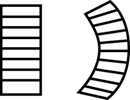
Since the wood won't "compress"
very much on the inside curve, it ends up getting "stretched" on
the outside curve, which is where it starts to crack. The crack then
follows the path of stress straight through the wood.

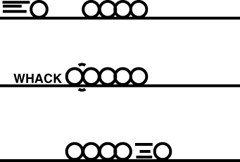
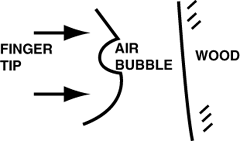
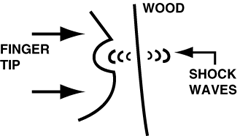


Copyright © 1998 by Guy L. Savelli. ALL RIGHTS RESERVED.
Except as otherwise provided by law, this writing may not be
produced in whole or in part, in any manner.